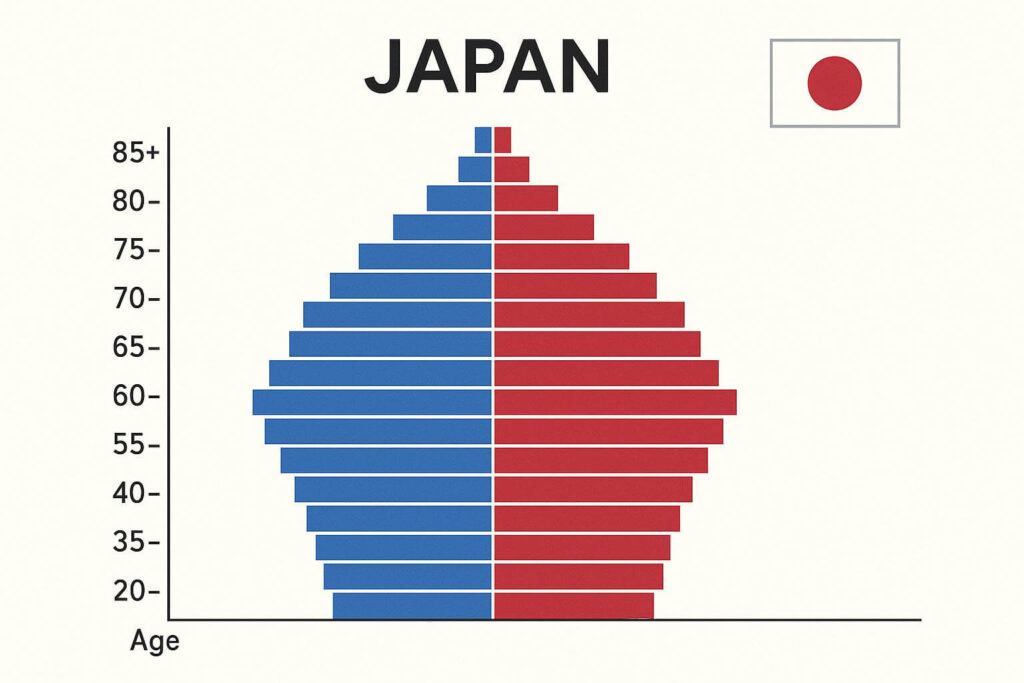Last Updated on 2025年8月23日 by Kenty
In 2025, Japan will face a major demographic shift that experts have long been warning about — known as “The 2025 Problem.” This issue centers around the country’s rapidly aging population, especially as the post-war baby boom generation turns 75 years old or older. But what exactly does this mean for Japan’s healthcare system, economy, and future?
If you’re planning to live in Japan, work in healthcare, or are simply interested in the country’s long-term challenges, here’s what you need to know.
👵 What Is Japan’s 2025 Problem?

The 2025 Problem refers to the year when all members of Japan’s “baby boomer generation” (born 1947–1949) will become 75 or older, officially classified as “late-stage elderly” (後期高齢者). This shift is expected to trigger:
- A dramatic increase in demand for medical and elderly care services
- Rising social security costs
- Workforce shortages in the caregiving sector
- Growing regional inequality, especially in rural areas
🧓 Why Is This a Big Deal?

Japan already has one of the world’s oldest populations. As of 2024:
- Over 29% of the population is aged 65 or older
- That number will keep rising in the coming decades
- By 2040, nearly 1 in 3 people will be over 65
This trend puts enormous pressure on public systems and the younger generations who support them.
💡 Related: Top 5 Cheapest Areas to Live in Tokyo for Foreigners (2025 Edition)
Urban migration due to aging populations is changing where people choose to live in Japan.
🏥 Key Challenges Japan Will Face

1. Healthcare System Overload
Japan’s universal healthcare is admired worldwide, but the system is under serious strain:
- More hospital visits and long-term care needs
- Shortage of doctors, nurses, and caregivers
- Overworked medical professionals
2. Ballooning Social Security Costs
Medical and pension-related expenses will skyrocket. Younger taxpayers will bear a heavier financial burden, increasing intergenerational tension.
3. Shortage of Care Workers
By 2025, Japan is expected to face a shortage of over 300,000 caregivers. To counter this, the government is increasingly relying on:
- Foreign care workers through visa programs
- Nursing robots and assistive technology
👀 Interested in caregiving culture in Japan?
Check out our guide on Experiencing Sumo & Chanko Nabe with Local Seniors in Asakusa
🏘 Regional Disparities

Rural towns are aging even faster than big cities. This leads to:
- Hospital closures in remote areas
- Seniors left without proper access to care
- Younger people moving to urban centers like Tokyo, Osaka, or Fukuoka
🏡 Planning a move? Read our guide to Affordable Areas Near Tokyo With Good Access
💡 What Is Japan Doing About It?

Japan is implementing several strategies:
- Community-based care: Offering local services so seniors can stay at home
- Elder-friendly tech: Robots, wearable monitors, and AI support tools
- Encouraging healthy aging: Diet, exercise, and social programs
- Foreign labor policies: Expanding caregiver visas from countries like Vietnam, Indonesia, and the Philippines
🌍 Why It Matters to Foreign Residents & Travelers

Whether you’re living in Japan or just visiting, the 2025 Problem affects everyone:
- Hospitals may be busier, especially in rural areas
- Demand for foreign workers is rising
- It’s a chance to witness how Japan tackles aging — something many countries will face eventually
🧳 Visiting Japan? Stay safe with our Japan Earthquake Preparedness Guide for Travelers
🧭 Final Thoughts
Japan’s 2025 Problem is not just about numbers — it’s about how a modern society adapts to aging gracefully. It’s a challenge, but also an opportunity to innovate and lead the world in elderly care.
Whether you’re considering long-term living, working in healthcare, or just curious about Japan’s future — understanding this issue is essential.





